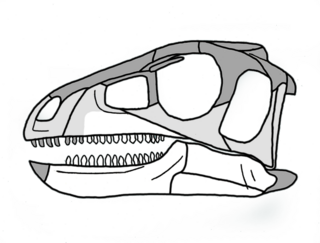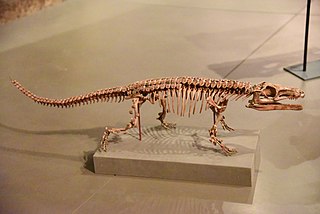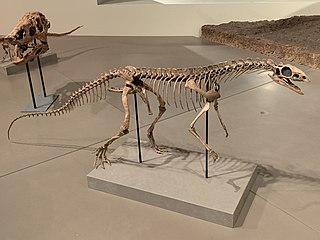
Agnosphitys is a genus of dinosauriform that lived during the Late Triassic. It contains only one species, the type species A. cromhallensis. Its remains include an ilium, maxilla, astragalus and humerus, which date variously from the Norian and Rhaetian stages of the Late Triassic, or possibly as late as the Hettangian stage of the Early Jurassic. The fissure fill at Avon, of which Agnosphitys was probably recovered from, was a sinkhole formed by the dissolution of Lower Carboniferous limestones.

Marasuchus is a genus of basal dinosauriform archosaur which is possibly synonymous with Lagosuchus. Both genera lived during the Late Triassic in what is now La Rioja Province, Argentina. Marasuchus contains a single species, Marasuchus lilloensis.

Pisanosaurus is an extinct genus of primitive dinosauriform that lived approximately 228 to 216 million years ago during the latter part of the Triassic Period in what is now South America. It was a small, lightly-built, ground-dwelling herbivore, that could grow up to an estimated 1 m (3.3 ft) long. Only one species, the type, Pisanosaurus mertii, is known, based on a single partial skeleton discovered in the Ischigualasto Formation of the Ischigualasto-Villa Unión Basin in northwestern Argentina.

Nyasasaurus is an extinct genus of avemetatarsalian reptile from the Middle Triassic Manda Formation of Tanzania that may be the earliest known dinosaur. The type species Nyasasaurus parringtoni was first described in 1956 in the doctoral thesis of English paleontologist Alan J. Charig, but it was not formally described until 2013.
Teleocrater is a genus of avemetatarsalian archosaur from the Middle Triassic Manda Formation of Tanzania. The name was coined by English paleontologist Alan Charig in his 1956 doctoral dissertation, but was only formally published in 2017 by Sterling Nesbitt and colleagues. The genus contains the type and only species T. rhadinus. Uncertainty over the affinities of Teleocrater have persisted since Charig's initial publication; they were not resolved until Nesbitt et al. performed a phylogenetic analysis. They found that Teleocrater is most closely related to the similarly enigmatic Yarasuchus, Dongusuchus, and Spondylosoma in a group that was named the Aphanosauria. Aphanosauria was found to be the sister group of the Ornithodira, the group containing dinosaurs and pterosaurs.

Dinosauromorpha is a clade of avemetatarsalian archosaurs that includes the Dinosauria (dinosaurs) and some of their close relatives. It was originally defined to include dinosauriforms and lagerpetids, with later formulations specifically excluding pterosaurs from the group. Birds are the only dinosauromorphs which survive to the present day.

Avemetatarsalia is a clade of diapsid reptiles containing all archosaurs more closely related to birds than to crocodilians. The two most successful groups of avemetatarsalians were the dinosaurs and pterosaurs. Dinosaurs were the largest terrestrial animals for much of the Mesozoic Era, and one group of small feathered dinosaurs has survived up to the present day. Pterosaurs were the first flying vertebrates and persisted through the Mesozoic before dying out at the Cretaceous-Paleogene (K-Pg) extinction event. Both dinosaurs and pterosaurs appeared in the Triassic Period, shortly after avemetatarsalians as a whole. The name Avemetatarsalia was first established by British palaeontologist Michael Benton in 1999. An alternate name is Panaves, or "all birds", in reference to its definition containing all animals, living or extinct, which are more closely related to birds than to crocodilians.

Dinosauriformes is a clade of archosaurian reptiles that include the dinosaurs and their most immediate relatives. All dinosauriforms are distinguished by several features, such as shortened forelimbs and a partially to fully perforated acetabulum, the hole in the hip socket traditionally used to define dinosaurs. The oldest known dinosauriform is Asilisaurus, a silesaurid which may have lived as early as the Anisian age of the middle Triassic period, about 245 million years ago.
Yarasuchus is an extinct genus of avemetatarsalian archosaur that lived during the Anisian stage of the Middle Triassic of India. The genus was named and described in 2005 from a collection of disarticulated but fairly complete fossil material found from the Middle Triassic Yerrapalli Formation. The material is thought to be from two individuals, possibly three, with one being much more complete and articulated than the other. The type and only species is Y. deccanensis. Yarasuchus was a quadruped roughly 2–2.5 metres (6.6–8.2 ft) long, with an elongated neck and tall spines on its vertebrae. Unlike other quadrupedal Triassic reptiles, the limbs and shoulders of Yarasuchus were slender, and more like those of ornithodirans.

Parringtonia is an extinct genus of Triassic archosaur within the family Erpetosuchidae, known from the type species Parringtonia gracilis. It is known from a single specimen, NHMUK R8646, found from the Anisian-age Manda Formation of Tanzania. This specimen, like most archosaur material from the Manda Formation, is fragmentary, including only a maxilla and a few postcranial bones. They show similarities with those of another archosaur called Erpetosuchus, known from the Middle Triassic of Scotland and the eastern United States. The phylogenetic placement of Parringtonia and Erpetosuchus are uncertain; some studies placed them close to the group Crocodylomorpha, which includes all modern crocodylians and many extinct forms that diversified after the Triassic, but this relationship has more recently been questioned.

Asilisaurus ; from Swahili, asili, and Greek, σαυρος is an extinct genus of silesaurid archosaur. The type species is Asilisaurus kongwe.Asilisaurus fossils were uncovered in the Manda Beds of Tanzania and date back to the Anisian stage of the Middle Triassic, making it one of the oldest known members of the Avemetatarsalia. It was the first non-dinosaurian dinosauriform recovered from Africa. The discovery of Asilisaurus has provided evidence for a rapid diversification of avemetatarsalians during the Middle Triassic, with the diversification of archosaurs during this time previously only documented in pseudosuchians.

Lagerpetidae is a family of basal avemetatarsalians. Though traditionally considered the earliest-diverging dinosauromorphs, fossils described in 2020 suggest that lagerpetids may instead be pterosauromorphs. Lagerpetid fossils are known from Late Triassic of Argentina, Arizona, Brazil, Madagascar, New Mexico, and Texas. They were typically small, although some lagerpetids, like Dromomeron gigas and a specimen from the Santa Rosa Formation attributed to Dromomeron sp., were able to get quite large. Lagerpetid fossils are rare; the most common finds are bones of the hindlimbs, which possessed a number of unique features.
Christian Alfred Sidor is an American vertebrate paleontologist. He is currently a Professor in the Department of Biology, University of Washington in Seattle, as well as Curator of Vertebrate Paleontology and Associate Director for Research and Collections at the Burke Museum of Natural History and Culture. His research focuses on Permian and Triassic tetrapod evolution, especially on therapsids.

Ignotosaurus is an extinct genus of silesaurid dinosauriform known from the Late Triassic (Carnian) Cancha de Bochas Member of the Ischigualasto Formation in the Ischigualasto-Villa Unión Basin in northwestern Argentina. It was therefore contemporary with early dinosaurs such as Herrerasaurus, and lived in the same place.
Gracilisuchidae is an extinct family of suchian archosaurs known from the early Middle Triassic to the early Late Triassic of China and Argentina.
Aphanosauria is an extinct group of reptiles distantly related to dinosaurs. They are at the base of a group known as Avemetatarsalia, one of two main branches of archosaurs. The other main branch, Pseudosuchia, includes modern crocodilians. Aphanosaurs possessed features from both groups, indicating that they are the oldest and most primitive known clade of avemetatarsalians, at least in terms of their position on the archosaur family tree. Other avemetatarsalians include the flying pterosaurs, small bipedal lagerpetids, herbivorous silesaurids, and the incredibly diverse dinosaurs, which survive to the present day in the form of birds. Aphanosauria is formally defined as the most inclusive clade containing Teleocrater rhadinus and Yarasuchus deccanensis but not Passer domesticus or Crocodylus niloticus. This group was first recognized during the description of Teleocrater. Although only known by a few genera, Aphanosaurs had a widespread distribution across Pangaea in the Middle Triassic.They were fairly slow quadrupedal long-necked carnivores, a biology more similar to basal archosaurs than to advanced avemetatarsalians such as pterosaurs, lagerpetids, and early dinosaurs. In addition, they seemingly possess 'crocodile-normal' ankles, showing that 'advanced mesotarsal' ankles were not basal to the whole clade of Avemetatarsalia. Nevertheless, they possessed elevated growth rates compared to their contemporaries, indicating that they grew quickly, more like birds than modern reptiles. Despite superficially resembling lizards, the closest modern relatives of aphanosaurs are birds.

Dracohors is a clade of dinosauriform archosaurs that includes dinosaurs and silesaurids. The oldest known dracohortian is Asilisaurus, dating to about 245 million years ago in the Anisian age of the middle Triassic period. According to Andrea Cau (2018), the synapomorphies of dracohortians are:
The anterior tympanic recess, the axial epipophyses, the centrodiapophyseal laminae in the presacral vertebrae, the relative size enlargement of the postacetabular process of ilium, the elongation of the pubis, the proximal sulcus and the reduction of the ligament tuber in the femoral head, and the further reduction in length of the fourth metatarsal and toe compared to the third.
Soumyasaurus is a small silesaurid dinosauriform from the Late Triassic (Norian) Cooper Canyon Formation of western Texas.

Kwanasaurus is an extinct genus of silesaurid dinosauromorph reptiles from the Late Triassic of Colorado. It is known from a single species, Kwanasaurus williamparkeri. Kwanasaurus had a deeper, stronger skull and greater specialization for herbivory compared to other silesaurids. It also possessed many unique characteristics of the snout, ilium, and lower part of the femur. It was described along with new specimens of Dromomeron from the Eagle Basin, the northernmost extent of the Chinle Formation.

Incertovenator is an extinct genus of archosauriform reptile, likely an archosaur, of uncertain affinities. Its unstable position is a result of possessing a number features found in both the bird-line avemetatarsalian archosaurs and the crocodylian-line pseudosuchians. The type and only known species is I. longicollum, which is known from single specimen discovered in the Late Triassic Ischigualasto Formation of Argentina. Incertovenator is known almost entirely by its vertebral column. This indicates that it had a relatively long neck, leading to its uncertain classification due to the convergent evolution of elongated neck vertebrae in both avemetatarsalian and pseudosuchian archosaurs.















